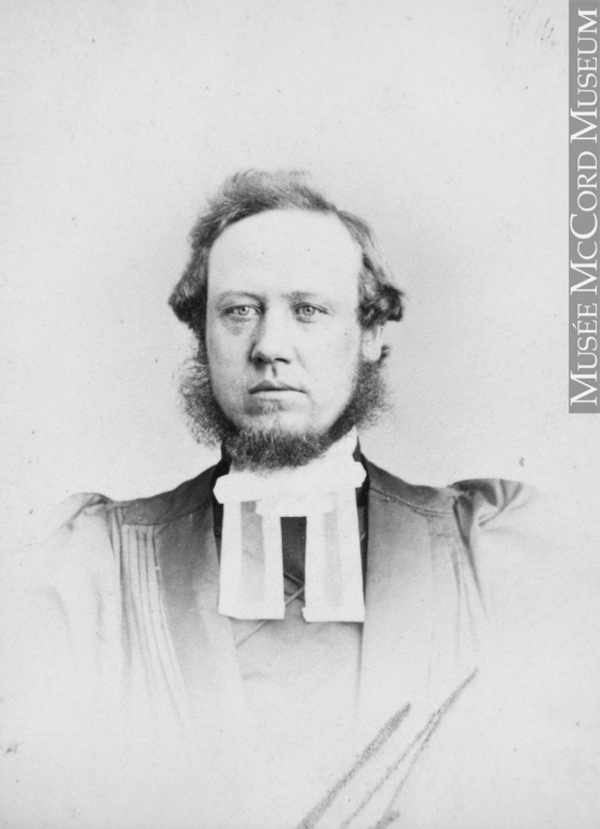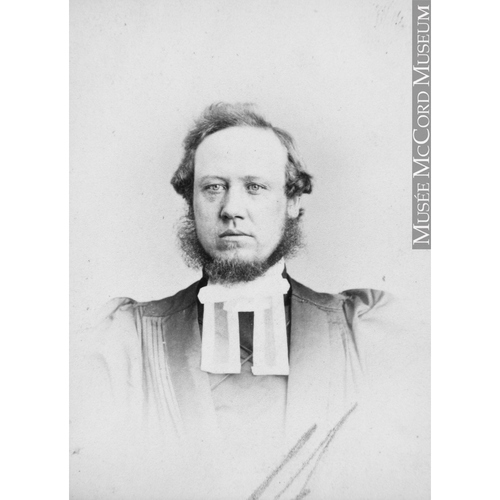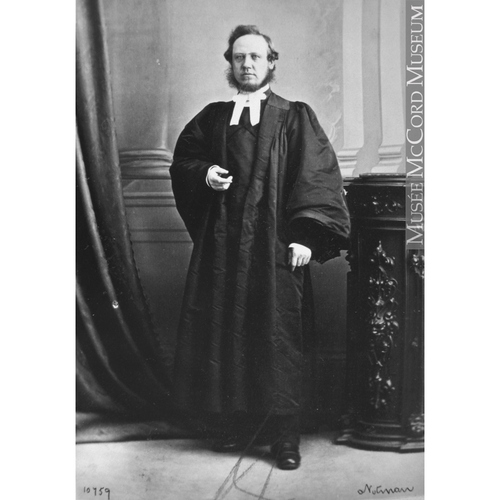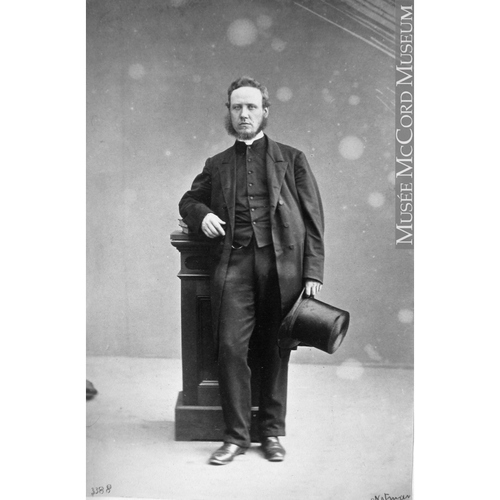
Source: Link
SNODGRASS, WILLIAM, Presbyterian minister and educator; b. 4 Sept. 1827 in Cardonald Mills, near Paisley, Scotland, son of John Snodgrass and Agnes Millar; d. 22 July 1906 in Kilmacolm, Scotland.
William Snodgrass was educated at his village school and at the grammar school in nearby Renfrew. Following a brief period at the University of Aberdeen, he completed his studies in arts and divinity between 1844 and 1852 at the University of Glasgow and was licensed to preach by the Church of Scotland’s Presbytery of Uist on 18 Aug. 1852. After receiving an appointment that same month from the Colonial Committee of the Church of Scotland as a missionary to Prince Edward Island, he was ordained by the Presbytery of Glasgow in September and then on the 29th he married Jessie Calder Pollok in Govan; they were to have three sons and five daughters, two of whom would die in infancy.
Snodgrass arrived in Charlottetown in late 1852 and became minister of St James’ Church. After three years he was again called by the congregation and on 14 Nov. 1855 was inducted. In 1856 he published an address given at the opening of the local Young Men’s Christian Association and he appears to have gained attention outside the Island as a preacher because in that year he was offered the prestigious position of minister of St Paul’s Church in Montreal in succession to Robert McGill*. He left Prince Edward Island in July and was inducted to St Paul’s on 4 November. During his seven-year pastorate in Montreal he enhanced his reputation as a preacher and distinguished himself as a leader in church affairs. From 1857 to 1864 he served as clerk of the synod of the Presbyterian Church of Canada in connection with the Church of Scotland, and from 1863 to 1865 he was editor of the Presbyterian. He was also one of the original board members of the Temporalities Fund, which was incorporated in 1858 to manage the money the church received after the secularization of the clergy reserves in 1854. During his years in Montreal Snodgrass published at least six sermons and addresses, and when he was appointed principal and “primarius professor of divinity” at Queen’s College in Kingston, Upper Canada, in August 1864, he published A minister’s farewell . . . , expressing his regrets to his congregation at leaving but explaining that this appointment was a call of duty that must be obeyed.
Snodgrass became the fifth principal of Queen’s, succeeding William Leitch* who had died in May 1864 from the pressure of work and the anxiety of that office. In recognition of the honour and responsibility of Snodgrass’s new position, the University of Glasgow conferred on him the degree of dd in February 1865. By that date his health was already suffering from the burdens of the principalship, and he was unable to teach for part of the winter term. He asked for help to reduce his workload, and offered to pay $400 towards the salary of an assistant to teach theology.
Deep divisions, scandals, and personality clashes had disrupted Queen’s during Leitch’s principalship, and by the time of Snodgrass’s arrival the college buildings were also in poor condition. In 1865 the number of students in arts had dropped to 34, of whom 15 were preparing for theological studies; the faculty of divinity itself had only 16 students. Including the medical students, the total enrolment was just 112. Moreover, between 1844 and 1866 only 36 per cent of the student body had belonged to the Church of Scotland, and only 46 per cent were Presbyterians. In 1864 the faculty of law had been disbanded, and in 1866, despite negotiations undertaken by Snodgrass, the medical faculty separated from the university to circumvent a requirement that professors sign the Westminster Confession and established the Royal College of Physicians and Surgeons of Kingston [see John Robinson Dickson*]; the college was, however, affiliated to Queen’s, which conferred the medical degrees.
In 1867 Queen’s suffered a crushing financial blow with the failure of the Kingston-based Commercial Bank of Canada, in which it was both a depositor and a shareholder, a collapse that erased about two-thirds of the college’s endowment funds. A further blow came at the end of that year when the government of John Sandfield Macdonald* announced the elimination of yearly grants to universities. These two developments reduced Queen’s annual income from $13,700 to $7,700. Snodgrass took the initiative in opposing the new governmental policy by seeking a united response from Queen’s, Victoria, the Methodist college at Cobourg, and Regiopolis, the Roman Catholic college at Kingston, and by consulting with Egerton Ryerson* and Bishop Edward John Horan* of Kingston. At an April meeting in Toronto, Snodgrass and President Samuel Sobieski Nelles* of Victoria proposed the creation of a “University of Ontario” with affiliated denominational colleges. The three colleges sent a letter of remonstrance to the federal government asking for remedial action to enforce the financial promises made in the University Act of 1853, but nothing was achieved by these efforts.
By 1869 Queen’s had only two students in the final year of arts and only six in the junior year. Revenues remained at $7,700, but expenditures stood at $11,000. To solve the crisis of finances and enrolments and to save Queen’s, the board of trustees proposed to raise an endowment of $100,000. Snodgrass and John Hugh MacKerras, professor of classics, promoted the plan before synod and then personally canvassed almost two-thirds of the 137 pastoral charges of the Church of Scotland in Ontario and Quebec. Although only some $87,000 had been received when the campaign officially ended in 1872, additional contributions raised the total to $114,000 from about 5,800 donors and Queen’s was placed on a firm financial base.
During his years as principal of Queen’s, Snodgrass’s personal qualities and selfless dedication won him the support of both faculty and synod. He was able to attract promising young scholars to its faculty, including MacKerras, Nathan Fellowes Dupuis* in 1868 to teach chemistry and natural history, and John Watson* in 1872 for philosophy. Beginning in 1870 women were admitted to Queen’s as auditors of special lectures in English given in the afternoons, though they were not permitted to enrol in degree programs for another decade. Snodgrass was characterized by admirers as “a burly Lowlander, whose practical, half-humorous sagacity all knew.” His leadership in what had been a troubled institution allowed him as early as February 1867 to report, “There is perfect peace within our walls.”
Before his appointment to Queen’s Snodgrass had supported the goal of the union of all the Presbyterian churches in Canada. In the summer of 1863 he and Leitch were commissioners of the Canadian synod to discuss the subject with the Church of Scotland synods of Nova Scotia and Prince Edward Island and of New Brunswick. In 1870 Snodgrass was one of his synod’s appointees to the joint union committee of the four Presbyterian churches in the central and Maritime provinces, chaired by Principal John Cook* of Morrin College at Quebec. The most contentious issue in the negotiations was the future of the various denominational colleges. This issue reflected the difference between the Church of Scotland tradition of teaching both arts and theology in one institution, as was the case at Queen’s, and the Free Church philosophy, illustrated by Knox College at Toronto, that the church colleges be confined to teaching theology, with all arts instruction given by the state. After opposing an attempt to eliminate theology from the curriculum of the two Church of Scotland colleges, Queen’s and Morrin, Snodgrass supported a compromise which allowed all the colleges of the uniting churches to continue operating as before. In the event, however, the Presbyterian Church in Canada, the result in 1875 of the negotiations, would give no financial support to the arts faculty of Queen’s and for theology provided almost six times as much money to Knox as to Queen’s.
In 1866 and for the last two years before the union of 1875 Snodgrass was elected moderator, the highest office in his church. In the general assembly of the new church he took a prominent role in helping his friend Daniel James Macdonnell* fight heresy charges in 1875, and he dissented twice from actions of the assembly against Macdonnell. In defending Macdonnell, Snodgrass was also defending Queen’s against Free Church doubts about the soundness of the theological teaching it provided. Nevertheless, in 1876 and 1877 Snodgrass was appointed to the senate of Knox College. In April 1879 Macdonnell joined the board of Queen’s.
Exhausted by his efforts over a period of 13 years to salvage Queen’s from its problems, Snodgrass accepted a call in 1877 to the Church of Scotland congregation in Canonbie, Scotland. He tendered his resignation to Queen’s in August and insisted that George Monro Grant, who had given him support during the Macdonnell trial, should succeed him. On 23 Nov. 1877 he was inducted to Canonbie by the Presbytery of Langholm. He revisited Canada in 1892 as a delegate to a meeting in Toronto of the Alliance of Reformed Churches holding the Presbyterian System. Four years later he retired to Kilmacolm where he died on 22 July 1906, survived by one son and one daughter.
William Snodgrass published seven sermons and addresses between 1856 and 1864, all of which have been made available on microfiche by the CIHM and are listed in its Reg.
QUA, Presbyterian Church of Canada records; Queen’s Univ., Board of Trustees, minutes, 1864–77; Queen’s Univ. letters, 1864–77. D. D. Calvin, Queen’s University at Kingston: the first century of a Scottish-Canadian foundation, 1841–1941 (Kingston, Ont., 1941). Robert Campbell, A history of the Scotch Presbyterian Church, St. Gabriel Street, Montreal (Montreal, 1887). [James Croil], A historical and statistical report of the Presbyterian Church in Canada, in connection with the Church of Scotland, for the year 1866 (2nd ed., Montreal, 1868), 67, 171; Life of the Rev. Alex. Mathieson, d.d., minister of St. Andrew’s Church, Montreal . . . (Montreal, 1870). Documentary history of education in Upper Canada from the passing of the Constitutional Act of 1791 to the close of Rev. Dr. Ryerson’s administration of the Education Department in 1876, ed. J. G. Hodgins (28v., Toronto, 1894–1910), 18–21, 23–24, 27. W. L. Grant and [C.] F. Hamilton, Principal Grant (Toronto, 1904). Life and work of D. J. Macdonnell, minister of St. Andrew’s Church, Toronto; with a selection of sermons and prayers, ed. J. F. McCurdy (Toronto, 1897). Malcolm McGillivray, “‘The makers of Queen’s’: William Snodgrass,
Cite This Article
John S. Moir and Shirley C. Spragge, “SNODGRASS, WILLIAM,” in Dictionary of Canadian Biography, vol. 13, University of Toronto/Université Laval, 2003–, accessed December 30, 2025, https://www.biographi.ca/en/bio/snodgrass_william_13E.html.
The citation above shows the format for footnotes and endnotes according to the Chicago manual of style (16th edition). Information to be used in other citation formats:
| Permalink: | https://www.biographi.ca/en/bio/snodgrass_william_13E.html |
| Author of Article: | John S. Moir and Shirley C. Spragge |
| Title of Article: | SNODGRASS, WILLIAM |
| Publication Name: | Dictionary of Canadian Biography, vol. 13 |
| Publisher: | University of Toronto/Université Laval |
| Year of publication: | 1994 |
| Year of revision: | 1994 |
| Access Date: | December 30, 2025 |






